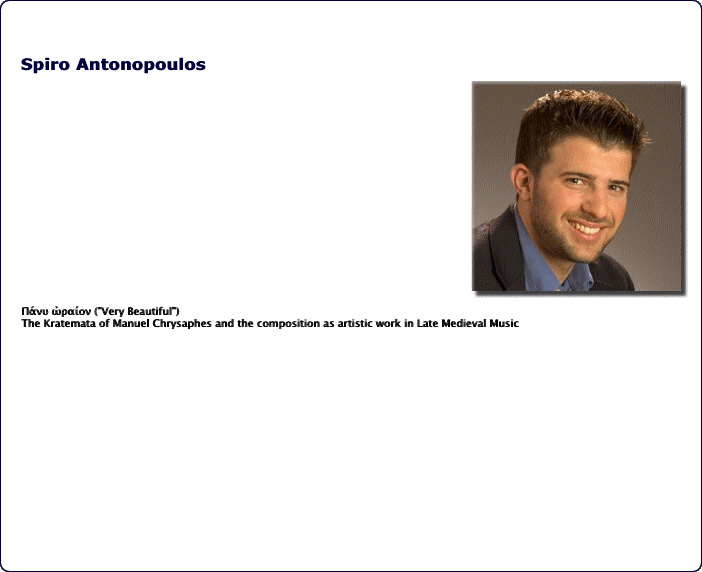

Spyridon Antonopoulos graduated from Brown University in Music and Classics before completing a Master’s in Opera Performance at the New England Conservatory. He is director of St. Mark’s Byzantine Choir in Roslindale, MA, and regularly performs with the acclaimed vocal ensemble Cappella Romana as well as with the London-based Byzantine Melodists. With the Greek Institute of Cambridge, MA, Mr. Antonopoulos is co-creator and artistic director of A Byzantine Christmas Celebration. As tenor soloist, he has performed with New England Conservatory Opera Theater, Opera Hub Boston, Brown University Chorus, and the MIT Concert Choir. He is completing his PhD at City University of London, focusing on the music of the fifteenth century imperial choirmaster, Manual Chrysaphes. Recently, he has spoken on a variety of subjects related to his dissertation research at both international musicology conferences in Greece and Cyprus, as well as conferences of Byzantine and Medieval Studies in Newcastle, London, and Kalamazoo, MI.
Manuscripts of the fourteenth and fifteenth centuries witness to a remarkable expansion of musical practices in the Eastern Mediterranean, expressed first in the work of the 13th-14th century maestros Xenos Korones and John Koukouzeles, and brought to fruition by the fifteenth century court musician, Manuel Chrysaphes. The components of this musical enrichment are primarily observed in the highly-personalized idiom of kalophonic (lit: ‘beautiful-sounding’) chant, a genre characterized by increased vocal embellishment and a loosening of traditional principles of modal homogeneity. Kalophonic works of these Late Palaiologan masters employed text-troping and the addition of nonsense syllables – terirem, tororo, and nenano, as a method of artistic expression, whether to rearticulate a musical idea, meditate on a particular phrase, or simply to extend liturgical action for practical reasons. The organic outgrowth of the so-called teretismata and nenanismata was the kratema (pl. kratemata), a through-composed, independent work, which by the seventeenth century began to command its own dedicated musical codex, the Kratematarion. Though largely neglected by early twentieth century scholars of Byzantine chant, the kratemata have garnered much scholarly attention in recent years by musicologists such as Luigi Abruzzo and Gregory Anastasiou, to name a few.
In this paper, I wish to examine the Kratema from the perspective of one singularly important musical personality, the aforementioned scribe, cantor, and theoretician, Manuel Chrysaphes. I argue that Chrysaphes’ theoretical Treatise, On the Theory of the Art of Chanting, articulates a strong conception of the composition as an artistic work, and moreover, that Chrysaphes presents the consummate musician as one which functions in large part as a composer – concepts relatively foreign even to early theoretical treatises of Western ecclesiastical music. These compositions were almost always ascribed to an individual creator, they were often given creative and exotic names (e.g., “Persian”, “Trumpet”, “Difficult”), and they employ a variety of compositional devices not seen in other genres. Reconciling the manuscript evidence related to this body of compositions with the theoretical treatise of Chrysaphes, we gain critical insight into not only the musical works themselves, but also the philosophy of a prominent Byzantine ecclesiastical musician. Although orality and some degree of extemporized performance persisted as fundamental components within the tradition of Byzantine psalmody, Chrysaphes’ treatise seems to shift the emphasis, as he declares the pre-eminence of the composer as authoritative creator and the composition as autonomous work.
